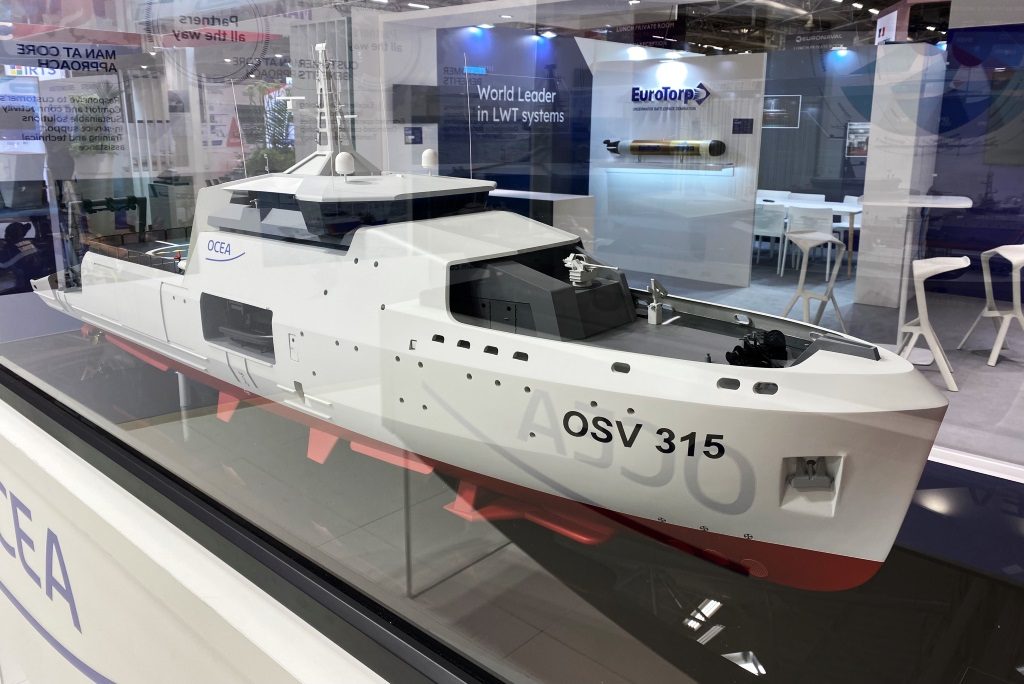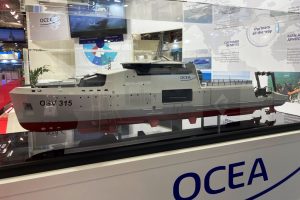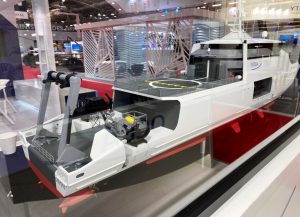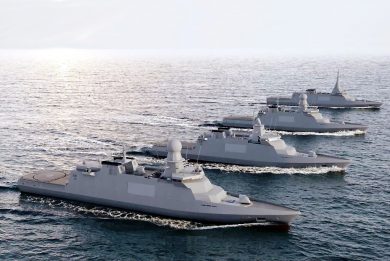
OCEA presents the 95 meters OSV 315 multi-purpose offshore support vessel
The more recent attention towards the protection and surveillance of national and exclusive economic zones and the ‘seabed warfare’, which increasingly requires the deployment of manned and unmanned surface and underwater platforms, confronted with budget constraints that require platforms characterized by versatility, modularity and autonomy, are key elements that drive the French OCEA shipyard development of the OSV 315 multi-purpose offshore support vessel.
The new platform design benefits from 35 years of experience in the design of offshore support vessels operating worldwide, as well as the green heritage of OCEA’s aluminium-made platforms that significantly reduce fuel consumption and CO2 emissions.
Based on the more recent developments in the hydro-oceanographic and multi-purpose OPV segment, with respectively the 58 meters OSV 190 Mk II delivered to the Indonesian and Nigerian Navies, and the 84 meters OPV 270 for the Philippines Coast Guard, OCEA shipyard has developed a multi-purpose platform available in three main configurations without introducing modifications to the general architecture: SC-WB (Hydrography – Oceanography), MCM (Mine Counter Measures) and SARR (Search And Rescue, Recovery).
With an overall length of 95 meters and a draught of 5 meters, the OSV 315 features a diesel-electric propulsion system based on four diesel generators powering two azimuthal thrusters providing a maximum speed of 18 knots under full load, and a range of 10,000 nm at 10 knots. The new platform design has accommodations for a crew of 70-80 members and 30-40 scientists.
To cope with the wide range of missions for which the OSV 315 has been designed, the platform is characterized by a stern working area covering up to 212 m2 followed toward the bow area by a modular mission bay. The amidship hull and superstructures accommodate a 64 m2 area for laboratories, in addition to two lateral stations for the launch and recovery of two 9 meters RHIBs alongside distributed and protected personnel accesses to the ship sides for research and operational duties. The stern area features a launch and recovery system for the deployment of both scientific equipment and drones and a lateral area for launch and recovery of an 8 meters hydrographic boat. Overtopped by an 11 tonnes helicopter flight deck with hangar for smaller rotary-wing platforms or unmanned vehicles, the modular mission bay is characterized by lateral opening doors allowing the launch and recovery on both sides of the vessel of unmanned or remote controlled vehicles, or other equipment.
At the rear of the mission bay we find a control station to manage the platform stern launch and recovery system and both the internal and external areas of operations. An internal bridge on the topside of the modular bay allows the personnel transit to the control station and stern area. As anticipated the OSV 315 can accommodate a wide range of unmanned or remote controlled vehicles including those capable to reach depth up to 6,000 meters. The new platform is also fully equipped in accordance to the International Hydrographic Organization (IHO) S-44 standards for hydrographic surveys related to the data acquisition, post-treatment and compilation of nautical charts. The OSV 315 is also equipped with a gondola under the forward hull section that can accommodate a range of underwater equipment, including and echosounder capable to work up to a depth of 11,000 meters. The OSV 315 can embark a complete package of equipment for seabed warfare as well as oceanographic equipment, and can be equipped with two firefighting monitors alongside refuelling at-sea stations. The new platform can also be armed, including a 20 mm gun installed in the bow area.
During Euronaval OCEA was also presenting the models of the 46 meters OPV 150 Gyptis operated by the French Maritime Affairs since June 2022 as well as the 84 meters OPV 270 Mk II, already in service since 2019 and well appreciated by the Philippines Coast Guard.
Photos courtesy L. Peruzzi






